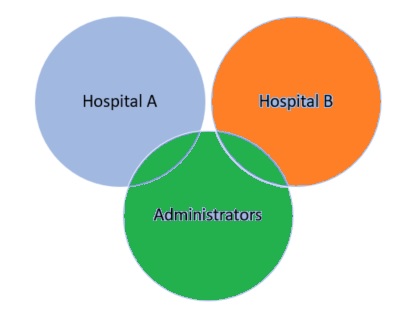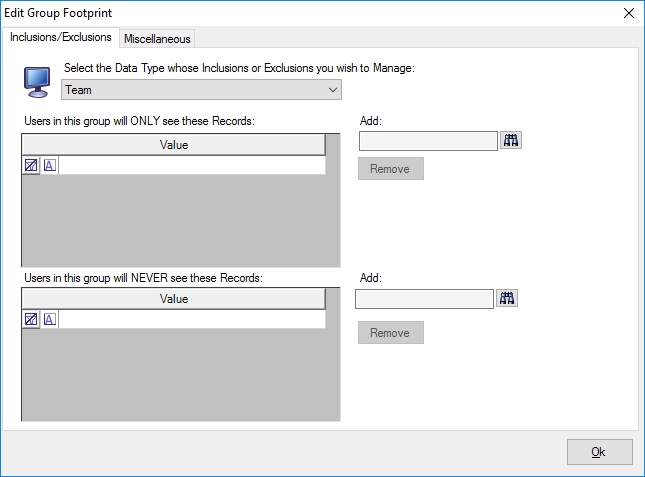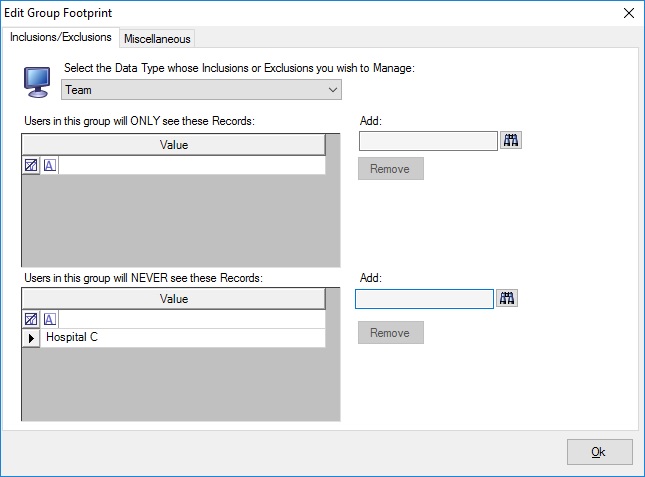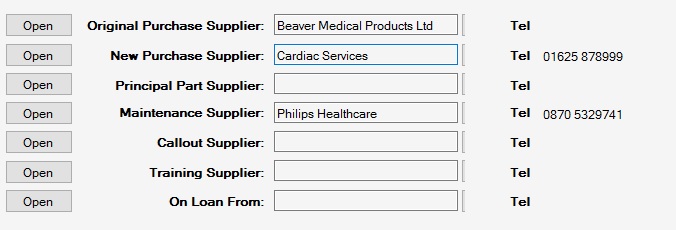If you haven’t already, it is strongly recommended that you read this blog article about groups & permissions before you look into group footprints. Just to recap, a footprint defines the parts of the database that a group of users can see.
The “Hospital A” group can maybe just see their own data, and likewise the “Hospital B” group might be only able to see theirs, but an administrator would be able to see data across both sites. This is not the same as a permission: all three groups have read access to equipment (for example); the footprint defines the data that they can actually see.
Discriminators
If you are going to split a dataset up into different chunks that can be seen by different people, then you will need some discriminator. i.e. some way of identifying which users can see which chunks. For example, the e-Quip database might be used by several completely independent sets of users; such as: Medical Physics, EBME, Facilities etc. How is it best to say, “this supplier is here for the Facilities users“, “this model is here for Medical Physics users“, etc? In some cases this is easy. You might, for example, be able to say, “this data should only be visible to users at Hospital A“. However, it can rapidly get quite complex. It might be that a spare part must be visible to users at both “Hospital A” and “Hospital B”, but the individual bins should only be visible to the appropriate site.
Far and away the most commonly-used discriminator in e-Quip is the team. It is for this reason that almost every screen in e-Quip has a team field. In the simplest case we simply define teams for “Hospital A” and “Hospital B“. We will dig into how this works, why it sometimes doesn’t and then some more complex alternatives.
How is a Footprint Different from a Filter?
Would it be sufficient to just create a base filter (i.e. a filter that the user can’t remove) for each team? Could you just add a filter of “… AND Team = ‘Hospital A” onto every search that “Hospital A” users make? Well, you could, but you would have to do this for every single screen. e-Quip allows you to create a base filter for every screen for a group but this would be quite time-consuming to manage. This would work, but wouldn’t handle lookups properly, since lookups can work from any screen. For example, you might have an equipment filter that says “… AND Team = ‘Hospital A” so you can only see “Hospital A” equipment, but if you were selecting the location for a device using the location lookup, the location lookup isn’t aware of equipment filters and so the lookup would show locations at all hospitals.
What we really need is an “entity-specific” mechanism rather than a “screen-specific” approach. This means that when we specify “you can only see information for Hospital A“, this restriction applies not only to every screen, but also to lookups. This, essentially, is the purpose of the Footprint Manager. While filters are screen-specific (and do not apply to lookups), footprints are entity-specific (and do apply to lookups).
Inclusions & Exclusions
The Footprint Manager takes discriminators and says “you can only see …” (an inclusion) or “you can never see …” (an exclusion). If you use a footprint to say “members of this group will only see data where the Team = Hospital A“, then this applies across all screens and also applies to lookups. These users will only see equipment, jobs, contracts etc., which have been assigned to the team “Hospital A“.
You might also want to specify a footprint by saying what users can’t see. A footprint might say “members of this group will never see decommissioned equipment“. If we combined these this might mean that “members of this group will only see data where Team = Hospital A but never show decommissioned equipment“. This would apply to every screen, so if the user clicked Show All Records on the equipment screen they would only see equipment assigned to the team Hospital A which was not decommissioned. The same reasoning would apply when raising a job; it would not be possible for a user with this footprint to create a job for a device for a team other than Hospital A, or for a decommissioned device.
So, an inclusion means “you can only ever see …”, while an exclusion means “you will never see …”.
Would you ever have an Inclusion and Exclusion on the Same Data type?
Basically, no! Is it meaningful to say “You can only ever see data from Hospital A and you will never see data from Hospital B“? If you can only see data from Hospital A there is no need to say that you cannot see data from Hospital B.
Using the Footprint Manager
The Footprint Manager is extremely simple to use. It is an external application under the Tools program files menu (depending on your operating system). When you run it you will be asked to enter a username and password. Once you have logged in you will see a list of groups. To edit a group footprint just double-click on the group.
At the top of the screen you will see a drop-down list which allows you to choose the discriminator that you have decided to use.
In order to specify a team inclusion on “Hospital A“, click the lookup at the top of the screen and select team “Hospital A“. For a manager you might also select an inclusion on “Hospital B“.
This means that these users can only see data which relates to teams “Hospital A” and “Hospital B“.
You might, alternatively, choose to say that these users can see all data except that which relates to “Hospital C“. This would be achieved with an exclusion.
The differences between these choices can be very subtle.
What about NULLs?
If you specify an exclusion, that is fairly unambiguous. i.e. “you will never see any data where the Team = Hospital A“. Any data at all, equipment, job, contract, spare part, location, anything at all; if the team is “Hospital A” then you won’t see it.
Inclusions are a bit more problematic. Let’s say that we have a spare part which is used in both Hospital A & B. However, there are bins for this part in Hospital A and Hospital B. The bins are no problem, we just assign the appropriate team, but what about the spare part itself? If the part is associated with only a single team (maybe it is a boiler spare part for the Facilities team) then there is no problem, but in this example the part needs to be visible to several teams.
This forces us to interpret inclusions as “you will only ever see data where either the Team = Hospital A or the Team is empty“. You can also see why this is the case when you look at entity types which appear several times within one record. For example, on the equipment property page there is not a single supplier field. rather, there are fields for Original Purchase supplier, New Item Purchase Supplier, Spare Part supplier, etc.
This is a device which was originally purchased from Beaver Medical but which is now purchased from Cardiac Services. Contracts, however, are purchased from Philips. Could we just rely on inclusions for Beaver Medical, Cardiac Services and Philips Healthcare? No, because the spare part supplier, callout supplier, training supplier and loan supplier are all blank. In order to display this record the inclusions would have to be interpreted as:
Supplier = Cardiac Services
OR
Supplier = Beaver Medical
OR
Supplier = Philips Medical
OR
Supplier is Empty
This will cause some headaches when we are looking at complex (or realistic) scenarios.
Alternative Discriminators
The team entity is the clear winner when it comes to choosing a discriminator which helps in “sharing out” your e-Quip database between different functional groups of users. However, there are alternative candidates.
Sites are commonly used for this purpose, i.e. “you can only see data where the Site = Hospital A“. For our non-NHS users the customer entity can also be useful, i.e. “you can only see data where the Customer = BUPA“.
e-Quip can handle many complex scenarios, but sometimes you may need to be very imaginative in how you decide to chop up your data.





